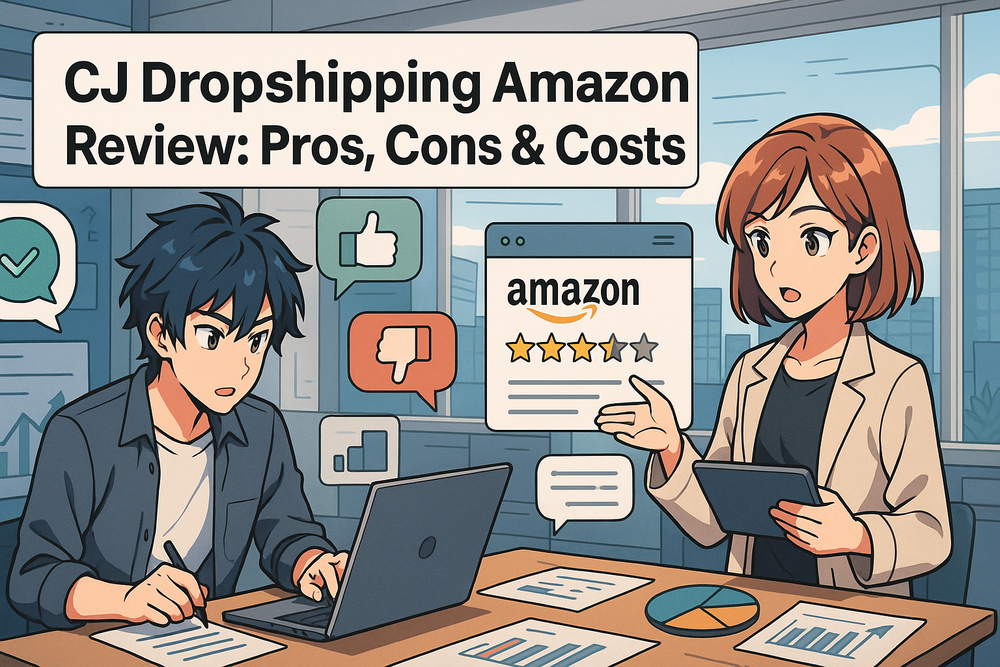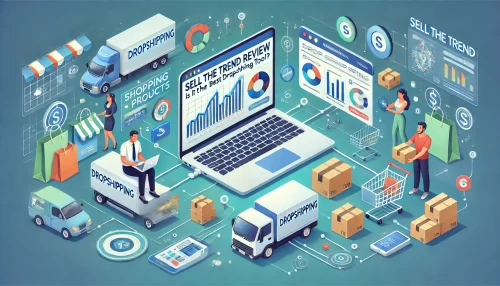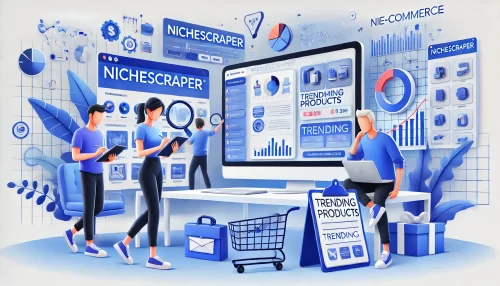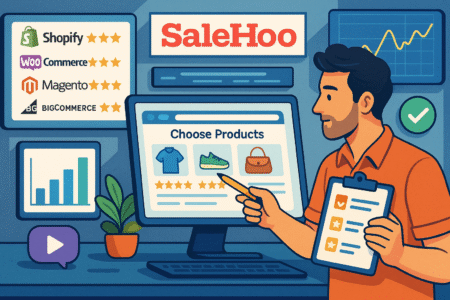Table of Contents
Ever wondered if CJ Dropshipping can actually work with Amazon? Is it a legit option for sellers looking to avoid the hassle of inventory, or does it come with hidden challenges? And what about the real costs—are they worth it for Amazon sellers trying to compete with Prime?
If you’ve been searching for answers about cj dropshipping amazon, you’re in the right place. In this guide, I’ll walk you through how CJ works with Amazon, the pros and cons of using it, and what kind of fees you’ll run into. Whether you’re just starting out or looking to optimize your current setup, this review gives you a clear, honest look at whether CJ is the right fit for your Amazon strategy.
Understanding How CJ Dropshipping Works With Amazon
CJ Dropshipping integrates with Amazon through third-party tools, but the relationship isn’t as straightforward as plug-and-play. Let’s unpack how it works and what you should expect if you’re thinking of selling CJ products on Amazon.
How CJ Dropshipping Connects to Amazon
While CJ Dropshipping doesn’t directly integrate with Amazon Seller Central, you can still use CJ products by manually fulfilling orders or using apps like Shopify or WooCommerce as intermediaries. Here’s how sellers typically approach it:
- Set up a storefront (Shopify/WooCommerce): CJ connects directly to these platforms.
- List products sourced from CJ on Amazon: You copy product listings manually or through product import tools.
- Manually fulfill Amazon orders using CJ: When a sale happens on Amazon, you place the order with CJ for fulfillment.
This roundabout method can work, but it requires a bit more hands-on effort and system syncing. Keep in mind, Amazon has strict fulfillment and delivery policies, so timing and product quality matter big time.
Limitations and Risks of Integration
Amazon’s fulfillment policies are strict—especially for delivery speed and tracking. Here’s where you need to tread carefully:
- Longer shipping times: CJ’s warehouses are mostly in China. Amazon buyers expect fast delivery.
- No Prime eligibility: Products shipped from CJ won’t qualify for Amazon Prime.
- Inconsistent tracking numbers: Amazon requires valid tracking; if CJ’s shipping providers don’t meet that, you risk account warnings.
It’s not impossible to make it work—but it’s a path better suited for experienced dropshippers who know how to manage multiple systems and customer expectations.
Pros of Using CJ Dropshipping With Amazon Sellers
While there are hurdles, many entrepreneurs still find CJ Dropshipping a compelling resource when selling on Amazon. Here’s why.
Advantages That Set CJ Dropshipping Apart
Let me break it down for you. Even with the manual steps involved, CJ offers several attractive features:
- No upfront inventory costs: Just like any dropshipping model, you don’t pay for stock until a customer orders.
- Product sourcing assistance: CJ helps find specific products or suppliers, which can be a game changer when Amazon sellers need something unique.
- Bulk purchasing options: If a product starts performing well, you can transition into bulk buying and faster shipping options.
- Custom packaging: Unlike many suppliers, CJ lets you brand your packaging—even in small quantities. This is huge for standing out on Amazon.
- US warehouses: For select products, CJ has domestic inventory which helps shorten shipping times dramatically.
For Amazon sellers experimenting with new products or looking to test ideas before committing to large inventory buys, these features create a lower-risk testing ground.
Cons to Consider When Using CJ Dropshipping for Amazon
Before you dive in, you’ll want to weigh the downsides too. Some of these can directly impact your Amazon seller account performance if not managed carefully.
Key Drawbacks That May Limit Your Success
Here’s what might give you pause if you’re thinking about using CJ Dropshipping with Amazon:
- Manual fulfillment is time-consuming: Since there’s no direct integration with Amazon, you need to be on top of orders every day.
- Shipping delays can hurt your metrics: If a package arrives late or tracking isn’t uploaded on time, Amazon may penalize your seller account.
- Inconsistent product quality: Reviews of CJ vary—some sellers love it, others report inconsistent quality or communication challenges.
- Language and support gaps: While CJ offers English support, response times can lag and support may not always grasp complex Amazon policy questions.
- No control over returns: Handling refunds and returns becomes tricky when you’re not physically touching the product.
In short, it works—but only if you’re willing to do the extra legwork and stay hyper-aware of Amazon’s seller policies.
CJ Dropshipping Amazon Costs Explained Clearly

Understanding the cost structure is essential before committing. Unlike many platforms, CJ doesn’t charge monthly fees—but the overall costs depend on what you’re selling, how it’s shipped, and where it’s going.
Breaking Down the Real Costs Involved
Here’s a quick look at where your money goes when using CJ Dropshipping with Amazon:
- Product price: Varies by item and supplier. Usually low since most products come from Chinese manufacturers.
- Shipping cost: Based on weight, dimensions, and delivery location. Shipping to the US from China typically ranges from $4 to $15 per order.
- Custom packaging: Optional but often worth the cost. Expect to pay extra per unit for branding.
- Warehousing fees (optional): If you stock products in a CJ US warehouse, storage fees apply after 30 days.
- Service fees: CJ generally doesn’t charge extra for order processing unless you need sourcing help or private labeling.
Compared to competitors like Alibaba or Oberlo, CJ’s pricing is transparent—but the shipping cost can stack up fast, especially if you’re competing with Prime sellers on Amazon.
Is CJ Dropshipping a Good Fit for Amazon Sellers?
CJ Dropshipping can work for Amazon sellers—but it’s not ideal for everyone. It depends on your goals, workflow, and how much manual effort you’re okay with.
Who Should (and Shouldn’t) Use CJ With Amazon
If you’re wondering whether CJ is the right call, here’s a simple way to think about it:
CJ might be right for you if you:
- Want to test product ideas before committing to inventory
- Already use Shopify or WooCommerce and sell on Amazon as a secondary channel
- Can manage manual order processes without automation
- Plan to build a brand and use custom packaging
You may want to look elsewhere if you:
- Rely heavily on Amazon Prime for conversions
- Need lightning-fast, automated fulfillment
- Sell high-volume or time-sensitive products
- Don’t want to deal with multiple platforms and manual syncing
Pro Tip for Smarter Selling – If you’re serious about combining CJ Dropshipping and Amazon, consider starting with a Shopify store synced to CJ, and then use Amazon’s Multi-Channel Fulfillment (MCF) to fulfill Amazon orders yourself. This keeps your tracking clean and gives you more control over delivery times.
CJ Dropshipping vs Other Platforms: What You Need to Know

Choosing a dropshipping platform can feel like trying to pick a favorite flavor at an ice cream shop—there are so many, and they all promise something sweet. Let’s break it down in a clear side-by-side comparison so you can decide if CJ Dropshipping is the right tool for your Amazon or ecommerce journey.
CJ Dropshipping vs Other Major Platforms
| Feature/Criteria | CJ Dropshipping | AliExpress | Zendrop | Spocket | DSers (AliExpress Partner) |
| Direct Amazon Integration | No (manual sync or via third-party tools) | No | No | No | No (uses AliExpress, indirect) |
| Shipping Speed (to US) | 7–15 days (faster with US warehouse items) | 10–30 days (varies by seller) | 5–12 days (with Express options) | 2–7 days (for US/EU suppliers) | 10–30 days typical |
| Product Quality Control | In-house quality checks, mixed reviews | Varies greatly by supplier | Pre-vetted suppliers | High-quality EU/US suppliers | Depends on AliExpress supplier |
| Custom Packaging & Branding | Yes (even for low MOQ) | Rarely available | Available on higher plans | Some branding options available | Rare, not standardized |
| Supplier Location | Mostly China, some US warehouses | Primarily China | Global (focus on US) | US and EU focus | China |
| App Integration | Shopify, WooCommerce, eBay, Etsy, TikTok | Shopify via Oberlo/DSers or manual | Shopify, WooCommerce | Shopify, WooCommerce | Shopify, WooCommerce |
| Customer Support | Live chat, tickets, sourcing support | Limited (contact individual sellers) | US-based team, faster replies | Responsive, good user experience | DSers support; AliExpress support varies |
| Best For | Custom packaging, Amazon test products | Broad product variety, low prices | Faster US shipping, branded experience | High-end feel with reliable shipping | Bulk import & automation with AliExpress |
| Pricing | Free to use; pay for services as needed | Free platform access | Free + paid plans (from $49/month) | Free + premium ($39.99+/month) | Free + optional upgrades |
When to Use CJ Dropshipping Over Other Tools
CJ Dropshipping stands out when you need more control without upfront investment. Here’s when CJ makes the most sense:
Use CJ Dropshipping if:
- You want custom packaging for brand building on Amazon or your store
- You’re sourcing niche or hard-to-find products
- You need sourcing help or private labeling options
- You plan to test new products before committing to inventory
While CJ isn’t perfect for Prime-level speed or full Amazon integration, it’s a strong fit for hybrid sellers balancing Shopify and Amazon or testing product-market fit.
Where Other Platforms Might Win Over CJ Dropshipping
Each competitor has its strong points depending on your goals, especially if fast fulfillment or automation is key.
Choose a Different Platform if You Need:
- Ultra-fast US shipping: Spocket and Zendrop offer faster local delivery, especially for US-based shoppers.
- Lower pricing options: AliExpress is still the go-to for cheap, bulk product variety (though quality control is a gamble).
- Built-in automation: DSers streamlines AliExpress bulk orders with more automation than CJ.
- Simplified experience: Zendrop offers more intuitive setup and faster onboarding for new sellers.
If you’re only selling on Amazon and want maximum automation, CJ may not be your top pick. But if you’re balancing multiple platforms or want to test and brand products without large investments, it’s a serious contender.
Pro Tip: Mix and Match for Strategic Growth
In my experience, the best sellers don’t stick to just one platform. Here’s a smart combo:
- Use Spocket or Zendrop for your top-tier, fast-moving Amazon listings.
- Use CJ Dropshipping for experimental products or branded goods where custom packaging sets you apart.
- Use AliExpress via DSers for trend testing or viral product launches.
This hybrid approach gives you speed, flexibility, and branding options—without putting all your eggs in one supplier basket.
How to Successfully Use CJ Dropshipping for Amazon Orders

Using CJ Dropshipping for Amazon might not be the most plug-and-play solution—but with the right workflow, it can still be a profitable setup. Here’s how you can make it work without running into the usual pitfalls.
Step-by-Step Workflow to Stay Organized
If you’re managing Amazon orders through CJ, creating a reliable system is essential. Here’s a simple flow that many sellers follow:
- Create your product listings on Amazon manually using high-quality images and descriptions sourced from CJ.
- Track incoming orders on Amazon and log them daily into CJ’s dashboard for fulfillment.
- Use CJ’s shipping calculator to choose the best shipping method based on location, speed, and price.
- Upload tracking numbers to Amazon as soon as they’re provided by CJ (usually within 24–48 hours).
- Monitor delivery times and customer feedback to spot any issues early before they escalate.
It’s a little extra work, but this system helps you stay compliant with Amazon’s performance metrics while still taking advantage of CJ’s low product costs and branding options.
Tools That Can Simplify the Process
Some sellers also use third-party tools to streamline parts of the process. A few helpful ones include:
- AutoDS: Syncs orders and uploads tracking automatically (great for multi-platform sellers).
- Shopify/Amazon Bridge Apps: Let you use Shopify as a hub where CJ connects, then fulfill Amazon orders via manual sync.
- Google Sheets or Airtable: Basic, but reliable tools for tracking order statuses and shipping times.
These tools help reduce manual errors and keep your Amazon account in good standing.
Tips to Protect Your Seller Account
Let me give you a few best practices that’ll save you trouble:
- Set realistic delivery estimates on Amazon based on CJ’s average shipping time—not their best-case scenario.
- Communicate delays clearly to buyers if an issue comes up.
- Avoid listing time-sensitive or seasonal items unless CJ’s US warehouse can fulfill them quickly.
Many sellers run into trouble because they assume everything will go smoothly. But if you stay proactive and build in a little buffer, you’ll stay ahead of most issues.
Final Thoughts: Is CJ Dropshipping Worth It for Amazon Sellers?
CJ Dropshipping isn’t a one-size-fits-all solution—but for the right kind of Amazon seller, it can offer serious advantages. The ability to source unique products, customize packaging, and test without upfront investment makes it a tempting option. Still, the lack of direct integration with Amazon and potential shipping delays means it’s not ideal for every situation.
If you’re someone who thrives on hands-on management and wants more control over product selection and branding, CJ might be a great fit. But if you’re chasing Prime-level delivery speeds or full automation, you may want to look at other platforms or hybrid models.
The key takeaway? CJ Dropshipping can work with Amazon, but it requires effort, consistency, and smart strategy to avoid the common pitfalls.
Ready to Get Started? If you’re curious about making CJ Dropshipping part of your Amazon selling toolkit, start small. Test one or two products, track everything, and build your workflow slowly.






